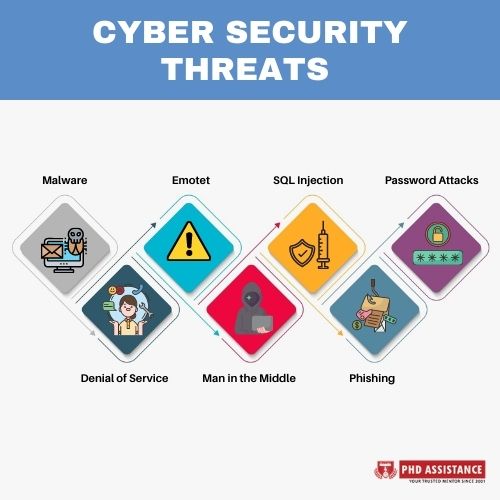7 Major Types of Cyber Security Threats
Computer systems are constantly protected against various cyberthreats by professionals in cyber security. Every day, private systems and enterprises are the targets of cyberattacks, whose variety has rapidly expanded. There are two categories of businesses, according to former Cisco CEO John Chambers: those that have been hacked and those who are still unaware that they’ve been attacked (Cisco, 2021).
Cyberattacks can have a variety of purposes. There are two. Cyber criminals may take a system offline and demand money to make it functional again. More complex than ever, ransomware is an assault that demands payment to unlock in order to restore services.
Cyber-attacks targets both businesses and individuals, often as a result of the personal information people save on their mobile devices and the usage of unsecure public networks (Almaiah et al., 2021).
To improve cyber security, it is essential to monitor changing and more frequent cyberattacks. An online cyber security master’s degree may be quite helpful for workers working to expand their understanding of dangers and cyber security information. Graduates of the online Master of Science in Cyber Security programme at the University of North Dakota may anticipate acquiring a thorough and sophisticated knowledge of cyber-attack techniques.
What Is a Cyber Security Threat?
Any potential malicious attack that aims to gain unauthorised access to data, interfere with digital activities, or contaminate information is referred to as a cyber security threat. Cyber threats may come from a variety of sources, including corporate espionage, hacktivists, terrorist organisations, adversarial nation-states, criminal organisations, lone hackers, and aggrieved individuals.
Sensitive data was disclosed as a result of multiple high-profile cyberattacks in recent years. 143 million people’s personal information, including birth dates, addresses, and Social Security numbers, were leaked in the 2017 Equifax breach, for instance. Marriott International said in 2018 that hackers had gained access to its systems and taken data from almost 500 million customers. In all cases, the organization’s inability to develop, test, and retest technological measures including encryption, authentication, and firewalls allowed the cyber security danger to persist (Banyal et al., 2020).
Cyber security experts are crucial for maintaining the security of private data since cyber attackers might utilise sensitive data to steal information or access bank accounts of an individual or a corporation, among other potentially detrimental acts.

7 Types of Cyber Security Threats
The following categories of cyber security dangers should be thoroughly understood by cyber security professionals.
Malware
Malware, which includes spyware, viruses, ransomware, and worms, is harmful software. When a user clicks on a malicious link or attachment, harmful software is installed, and malware is triggered. According to Cisco, once triggered, malware can:
- preventing access to important network components (ransomware)
- Install more malicious software.
- Collect data secretly by sending data from the storage device (spyware)
- Individual components can be harmed, rendering the system useless.
Denial of Service
A cyber-attack known as a denial of service (DoS) bombards a computer or network with requests, preventing it from responding. The same technique is accomplished via a distributed DoS (DDoS), except the assault comes from a computer network. Flood attacks are frequently used by cyber attackers to disrupt the “handshake” procedure and do a DoS. There are several other methods that may be employed, and some cybercriminals make use of networks being down to conduct additional attacks (Li & Liu, 2021). According to Jeff Melnick of the information technology security software business Netwrix, a botnet is a sort of DDoS in which millions of devices may be infected with malware and managed by a hacker. The processing power of a target is targeted and overpowered by botnets, also known as zombie computers. Botnets are difficult to track down and spread over several places.
Emotet
Emotet is described as “an sophisticated, modular banking Trojan that primarily serves as a downloader or dropper of other banking Trojans” by the Cybersecurity and Infrastructure Security Agency (CISA). Emotet is still among the priciest and most harmful spyware.
Man in the Middle
When hackers interject themselves into a two-party transaction, a man-in-the-middle (MITM) assault takes place. According to Cisco, they may filter and take data after disrupting the transmission. When a visitor makes use of an unprotected public Wi-Fi network, MITM assaults frequently happen. Attackers place themselves in the way of the visitor and the network, then employ malware to set up dangerous software and access data (Podder et al., 2021).
SQL Injection
A specific kind of cyberattack called a Structured Query Language (SQL) injection happens when malicious code is inserted into a server that supports SQL. The server divulges information when infected. Simply typing the malicious code into a search box on a susceptible website can submit it.
Phishing
Phishing attacks employ fake correspondence, such an email, to con the recipient into opening it and following the instructions contained therein, like entering a credit card information. According to Cisco, the intention is to steal personal information like credit card numbers and login credentials or to infect the victim’s computer with malware.
Password Attacks
An online hacker may gain access to a variety of data with the proper password. Data Insider describes social engineering, a sort of password assault, as “a tactic cyber attackers utilise that depends largely on human connection and frequently entails persuading individuals into violating basic security measures.” Accessing a password database or guessing a password straight are two more methods of password attacks (Patil et al., 2020).
Therefore, to safeguard their operations and data, businesses and government bodies require the highest level of cyber security. For cyber security specialists, it is crucial to comprehend how to handle the most recent, changing cyber threats.
At phd assistance, Our professional experts always stive to give the best results in assisting the PhD scholars
References
Almaiah, M. A., Al-Zahrani, A., Almomani, O., & Alhwaitat, A. K. (2021). Classification of Cyber Security Threats on Mobile Devices and Applications (pp. 107–123). https://doi.org/10.1007/978-3-030-74575-2_6
Banyal, S., Bhardwaj, K. K., & Sharma, D. K. (2020). Cyber Attack Analysis and Attack Patterns in IoT-Enabled Technologies. IoT: Security and Privacy Paradigm, 133. https://books.google.com/books?hl=en&lr=&id=DtbpDwAAQBAJ&oi=fnd&pg=PA133&dq=cyber+attack+analysis+and+attack+patterns+in+IoT+enabled+technologies+by+siddhanth+banyal&ots=DHFjYjH-he&sig=-Ydo-twaoQI7q92uxjbovnTlYr0
Cisco. (2021). What Are the Most Common Cyber Attacks? https://www.cisco.com/c/en_in/products/security/common-cyberattacks.html
Li, Y., & Liu, Q. (2021). A comprehensive review study of cyber-attacks and cyber security; Emerging trends and recent developments. Energy Reports, 7, 8176–8186. https://doi.org/10.1016/j.egyr.2021.08.126
Patil, B. P., Kharade, K. G., & Kamat, R. K. (2020). Investigation on data security threats & solutions. International Journal of Innovative Science and Research Technology, 5(1), 79–83. https://www.researchgate.net/profile/Kabir-Kharade/publication/358461575_Investigation_on_Data_Security_Threats_Solutions/links/62038888c83d2b75dffc4dfa/Investigation-on-Data-Security-Threats-Solutions.pdf
Podder, P., Mondal, M., Bharati, S., & Paul, P. K. (2021). Review on the security threats of internet of things. ArXiv Preprint ArXiv:2101.05614. https://arxiv.org/abs/2101.05614
 Previous Post
Previous Post Next Post
Next Post
